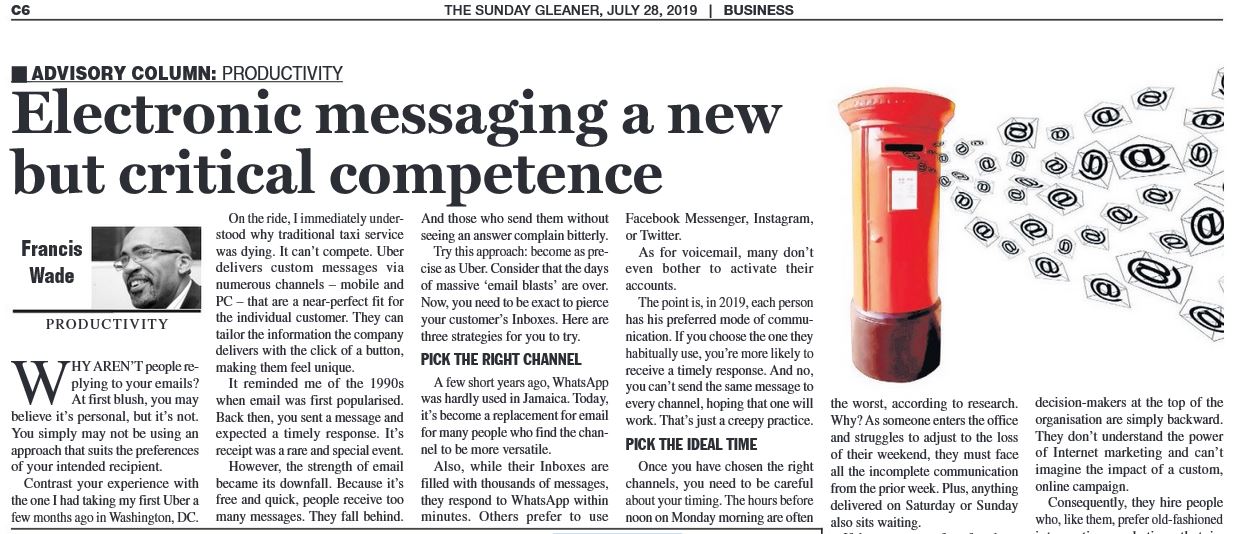Why aren’t people replying to your emails? At first blush, you may believe it’s personal, but it’s not. You simply may not be using an approach that suits the preferences of your intended recipient.
Contrast your experience with the one I had taking my first Uber a few months ago in Washington, DC. On the ride, I immediately understood why traditional taxi service was dying. It can’t compete. Uber delivers custom messages via numerous channels (mobile and PC) that are a near-perfect fit for the individual customer. He/she can tailor the information the company delivers with the click of a button, making them feel unique.
It reminded me of the 1990’s when email was first popularized. Back then, you sent a message and expected a timely response. It’s receipt was a rare and special event.
However, the strength of email became its downfall. Because it’s free and quick, people receive too many messages. They fall behind. And those who send them without seeing an answer complain bitterly.
Try this approach: become as precise as Uber. Consider that the days of massive “email blasts” are over. Now, you need to be exact to pierce your customer’s Inboxes. Here are three strategies for you to try.
1. Pick the right channel
A few short years ago, WhatsApp was hardly used in Jamaica. Today, it’s become a replacement for email for many people who find the channel to be more versatile.
Also, while their Inboxes are filled with thousands of messages, they respond to WhatsApp within minutes. Others prefer to use Facebook Messenger, Instagram or Twitter.
As for voicemail? Many don’t even bother to activate their accounts.
The point is, in 2019 each person has their preferred mode of communication. If you choose the one they habitually use, you’re more likely to receive a timely response. And no, you can’t send the same message to every channel , hoping that one will work. That’s just a creepy practice.
2. Pick the ideal time
Once you have chosen the right channels you need to be be careful about your timing. The hours before noon on Monday morning are often the worst, according to research. Why? As someone enters the office and struggles to adjust to the loss of their weekend, they must face all the incomplete communication from the prior week. Plus, anything delivered on Saturday or Sunday also sits waiting.
If they were away for a few days, it’s even worse. Upon their return, they are only in the mood for brutal culling and your message could get cut without ever being read.
Instead, use a version of the Golden Rule. Send messages as you would wish they were sent to you – on your preferred schedule. Do so skillfully and you’ll improve the odds dramatically that it won’t be lost.
Thankfully, scientists have given us some further clues. In a recent summary of 14 studies on the topic, Coschedule.com reported that Tuesday is the best weekday, followed by Thursday and Wednesday.
The optimal times of day? Just before lunch or before bed.
Unfortunately, these are US studies where work norms are somewhat different. You’ll have to do your own experiments to determine top results.
3. Use automated software
A surprising number of local organizations don’t collect any kind of contact information. As a consumer, this puzzles me. After all, once I have become a customer, I am quite likely to repeat the purchase, if only I were reminded via electronic messaging.
My sense is that the practice is uncommon because decision-makers at the top of the organization are simply backward. They don’t understand the power of internet marketing and can’t imagine the impact of a custom, online campaign. Consequently, they hire people who, like them, prefer old-fashioned interruption-marketing i.e. advertisements in print, television, radio and billboard. The poor decisions they make aren’t questioned.
Fortunately, automated messaging on both email and social networks is relatively inexpensive. They also allow you to collect data easily, often putting the onus on customers to join via your landing pages.
Furthermore, once they join your network, you’re able to track their behavior and learn a great deal about their individual preferences. Once you analyze this information, you can understand how to speak to their needs in increasingly surgical ways.
The fact is, if your company isn’t using these tools and knowledge you are setting yourself up for disruption: the moment when a competitor figures out that your business is stale. Don’t be like the taxi companies who may never catch up to Uber. Adjust your digital communication to fit your customer’s needs.

Chronicles from a Caribbean Cubicle
New Thinking from Framework Consulting
